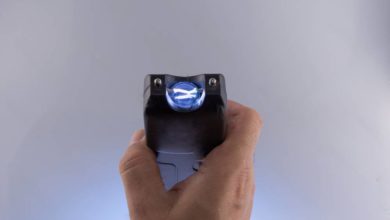Do Stun Guns Leave Marks?
Stun guns, a prevalent tool in self-defense and law enforcement, often raise questions about their safety and physical effects. Stun gun use has been associated with various injuries, including muscle soreness, puncture wounds, cuts, bruises, and, in rare cases, serious health issues. [1] A common inquiry is whether these devices leave marks on the body. You can learn more about the physical effects of stun guns on the skin and other parts of the body after a taze by reading on.
“Stun guns are designed for non-lethal self-defense.”
Stun Gun Marks from Electroshock
Stun guns are electroshock weapons designed for non-lethal self-defense. They incapacitate a potential assailant by delivering a high-voltage, low-current electrical charge. This charge disrupts the body’s neuromuscular system, causing temporary disorientation and loss of muscle control without causing permanent harm.
How Do Stun Guns Work?
Stun guns create an electrical circuit between the device and the target. A study on deaths following electro-muscular disruption involved a medical panel composed of physicians, medical examiners, and specialists in various fields. [2]
They found that when activated, they emit an electrical charge through two metal probes. This charge, upon making contact, disrupts the neuromuscular system’s normal functioning, leading to involuntary muscle contractions and temporary incapacitation.
“When activated, stun guns emit an electrical charge through two metal probes.”
Physical Effects of Stun Guns
The primary effect of a stun gun is non-lethal incapacitation. The electrical charge leads to muscle spasms, disorientation, and sometimes pain, lasting from a few seconds to several minutes. The low current level is designed to ensure the charge is non-lethal.
Do Stun Guns Leave Marks?
The impact of stun guns on the skin and body is a nuanced topic. Generally, stun guns can leave two types of marks:
Surface Marks
Direct contact with the skin can result in minor burns or red marks from the metal probes. These are usually superficial and heal within a few days. The severity depends on the stun gun’s voltage and the duration of contact.
Internal Effects
While not visible, the electrical charge can cause internal effects like muscle soreness and fatigue. In rare cases, and especially in individuals with pre-existing health conditions, the consequences can be more severe.
Factors Influencing the Severity of Marks
The severity of marks from a stun gun can vary based on several factors:
-
Duration of Contact: Prolonged exposure increases the likelihood of visible marks.
-
Voltage of the Stun Gun: Higher voltages can lead to more pronounced marks.
-
Skin Sensitivity: Individuals with sensitive skin may show more noticeable effects.
-
Clothing: Thick clothing can mitigate the severity of surface marks.
Medical Perspective
Medically, the effects of stun guns are generally seen as temporary and safe. However, it’s advisable to seek medical attention if there are concerns about the marks or if the individual has health issues.
Legal and Ethical Considerations
The use of stun guns is regulated by specific legal and ethical guidelines that vary by region. Users must adhere to these laws, which often dictate where and how stun guns can be carried and used.
Responsible usage is paramount, ensuring they are employed only when necessary and in a manner that minimizes harm. Understanding local regulations and the moral implications of using such a device is crucial for lawful and ethical conduct.
FAQs
1. Do stun guns cause permanent damage?
No, stun guns are designed to incapacitate temporarily without causing permanent damage.
2. Can stun guns be lethal?
While designed as non-lethal tools, in very rare cases, especially with pre-existing health conditions, they can have severe consequences.
3. Should I seek medical attention if a stun gun is used on me?
Yes, it’s advisable to consult a medical professional, especially if you experience prolonged discomfort or have underlying health conditions.
Conclusion
Stun guns, when used appropriately, are a safe and effective self-defense tool. They can leave temporary marks, but these are generally minor. Understanding their operation and effects is crucial for responsible usage. Awareness of legal and ethical implications is also important for anyone considering using a stun gun.
To learn more about Tasers’ safety disabling pin, read through our blogs at Security Forward today.



